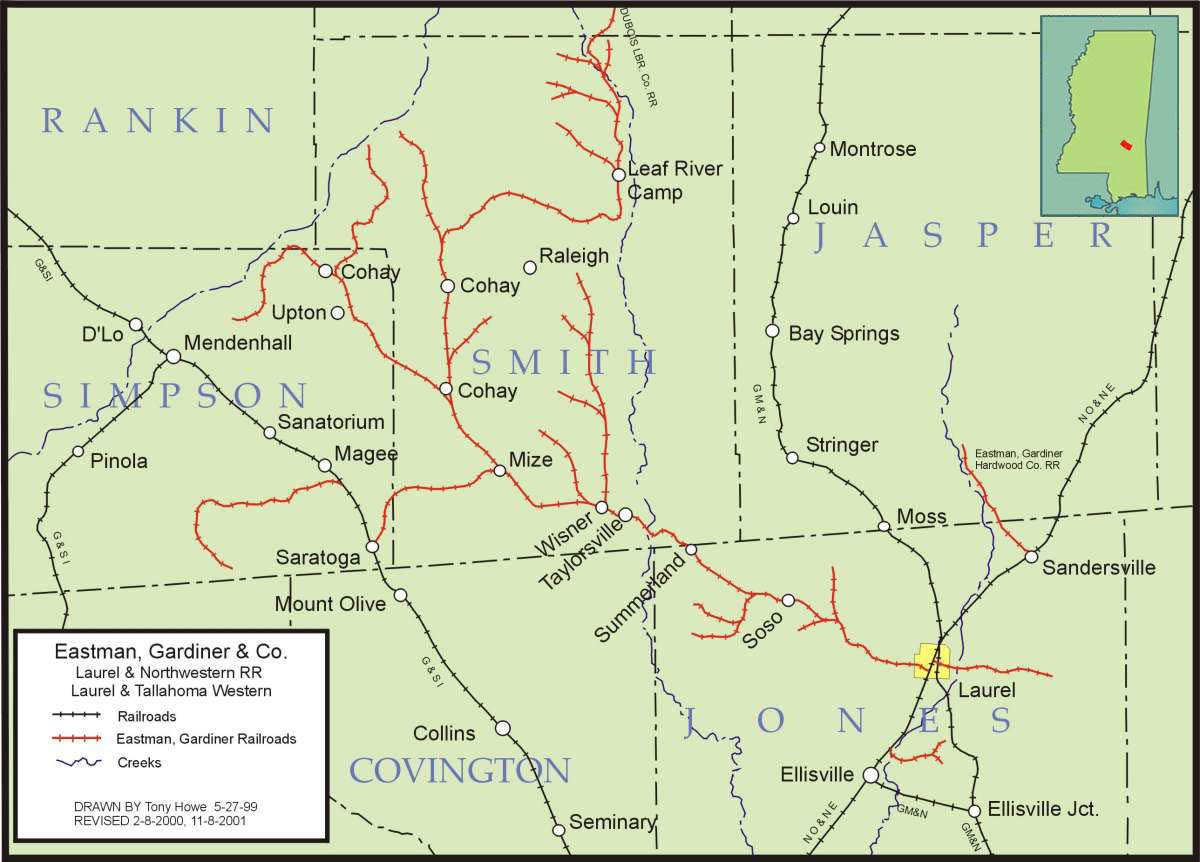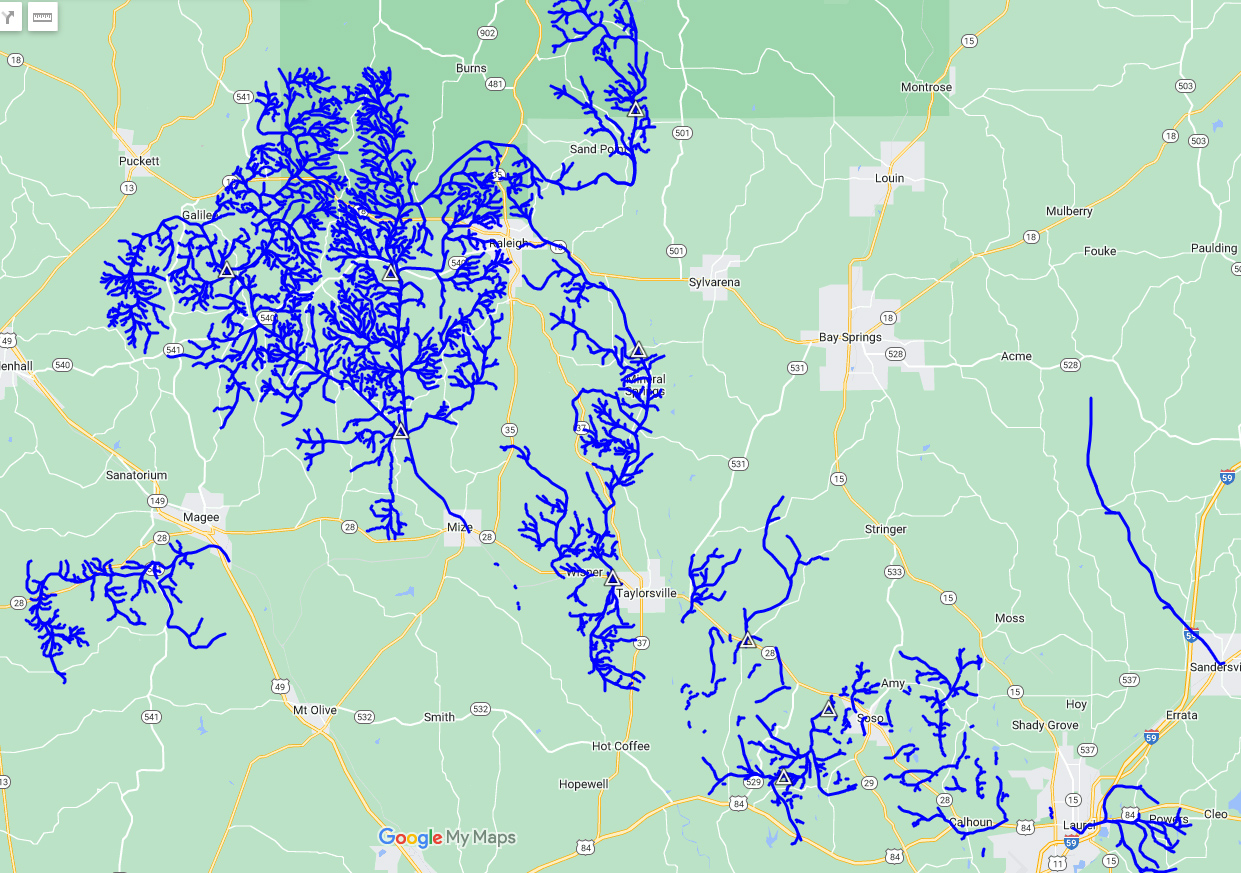
Eastman, Gardiner & Co. (1891-1937)
Laurel & Northwestern Railway (1897-1900)
Laurel & Tallahoma Western Railway (1900-1937)
|
Standard Gauge Headquarters: Laurel, MS (Jones County) Years of Operation: 1891-1937 Mill Capacity: 220,000 ft/day Miles Operated: 60 Locomotives Owned: |
Equipment: 200 cars, 4 Barnhart loaders, 2 home-made skidders in 1910 June 30, 1914- 8 locomotives, 3 passenger, 20 box, 4 water, 6 flats, 100 log cars |
Click Map for Larger Version Detailed Google Maps Version HERE |
|
History by Tony Howe:
On April 1, 1891 Eastman, Gardiner & Company, of Lyons, Iowa,
purchased the sawmill plant at Laurel, Mississippi, and approximately 26,000
acres of timber land, of the Kamper & Lewin Manufacturing Company.
The mill was located on the south side of downtown Laurel, near the
present-day Sawmill Square Mall. Eastman, Gardiner & Co. was composed of
George S. Gardiner, his brother Silas Gardiner, and brother-in-law Lauren C.
Eastman. Lauren’s brother Charles S. Eastman was also involved in the
company for the first few years. Other members of the family eventually
joined in the company, as well. George S. Gardiner served as president of
the company from its founding until his death in 1921.
The Kamper & Lewin plant included a sawmill, shingle mill,
planing mill, dry kilns and pole logging road. The pole road was replaced
with a standard gauge steel-rail logging railroad running east from the mill
by late 1891. Much additional timber land was added to the company holdings
throughout the 1890's. About 60,000 acres were purchased in 1899 alone. The
old sawmill was replaced by a much larger mill in 1893, which could cut 25
million feet of lumber per year. In 1897-98, the capacity of the mill was
increased to 40 million feet per year with the addition of a band saw to the
mill equipment. Capacity was increased again in 1902, when the company added
a second band mill and bought the adjacent mill of the Laurel Lumber
Company, which boosted production capacity to 60 million board feet of
lumber per year.
To supply the ever-increasing demand for logs, the company’s
logging railroad was also greatly expanded. A new logging railroad was built
in 1897 running northwest from the sawmill. This railroad was named the
“Laurel and Northwestern Railway.” The old rail line running east from
Laurel was removed after the logging camp was moved to the new cutting area
northwest of town in mid-1897. This portable camp was moved frequently as
logging operations moved slowly westward. By 1905 the camp was at
Summerland, on the Jones-Smith County line. From this time on, logging
operations were conducted in Smith, Covington, and Simpson Counties. The
main line of the Eastman, Gardiner & Co.’s logging railroad reached
the Leaf River near Taylorsville in 1899. At this time, the part of the
railroad running from Laurel to this point was sold to the Gulf & Ship
Island Railroad, and completed to a connection with their main line at
Saratoga by the following year. Eastman, Gardiner & Co. retained the
right to run their log trains over the railroad from their own logging spurs
built off of the G&SI to the mill in Laurel. At this time Eastman,
Gardiner & Co.’s railroad was renamed the “Laurel and Tallahoma
Western Railway.” By 1908 the
company’s logging camp at Wisner, two miles west of Taylorsville, had
grown large enough to be incorporated as a town. After a brief stay at
Rogers Camp, the main camp was moved several miles north of Mize and renamed
Cohay in 1915. This would be the first of three camp locations to be called
by that name. The camp was relocated to a point northeast of Raleigh in 1929
and called Leaf River Camp. In 1934 it was moved again to a point southeast
of Magee, where it remained until the company stopped logging by rail in
1937. In 1917, the company built a hardwood mill
west of their main mills in Laurel, and formed the Eastman-Gardiner Hardwood
Company. Before this time, the company primarily cut pine, both longleaf and
shortleaf varieties. In 1928 the officers of Eastman, Gardiner & Co.
also formed the Pascagoula Hardwood Co. to log a tract of hardwood timber in
the Pascagoula River basin in George and Jackson Counties. This company
built a large mill in southeast Laurel near the Masonite Corporation plant.
It operated until 1933, and was sold to the Mengel Co. in November 1935, who
ran the mill many more years. The Mengel Company stopped logging by rail in
1947.
For a detailed history of this company, see our new book YELLOW PINE CAPITAL |
||
|
|
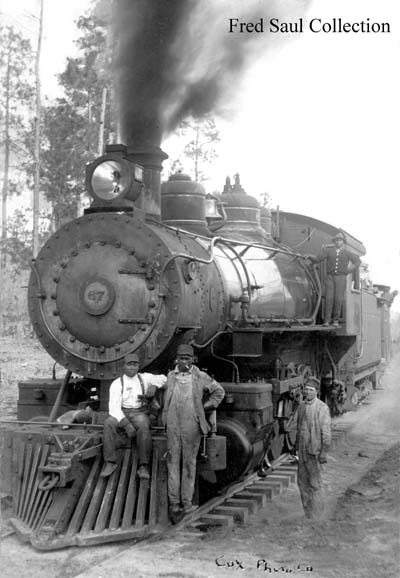 Eastman, Gardiner & Co. had a rare 4-8-0 used on the mainline log train for many years. Here crew members pose on front of No. 67 about 1910.
|
|
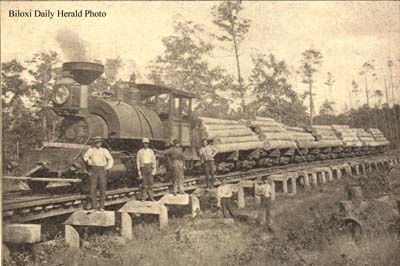
Eastman, Gardiner & Co.'s first locomotive crossing a long low trestle about 1902. |
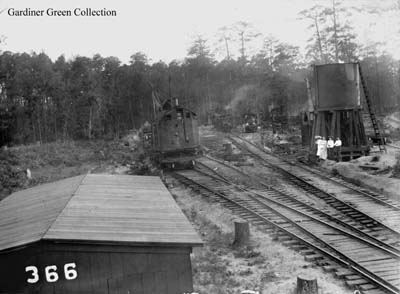
Locomotives and loaders at the company's servicing facilities at what is probably Hebron Camp about 1904. |
|
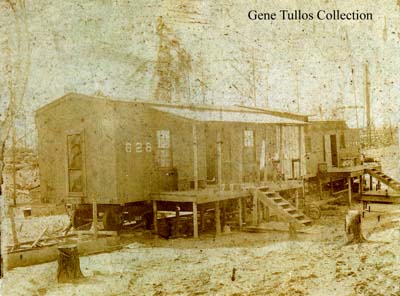
Eastman, Gardiner & Co. camp cars about 1905. |
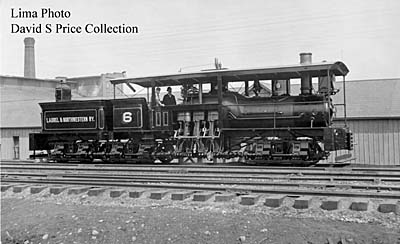 Shay Number 6 was built new for E-G with a full-length canopy, a feature of Shays built for Eastman, Gardiner & Co. It is also lettered for the short-lived Laurel & Northwestern. |

Shay 3 at an early E-G camp about 1896. |
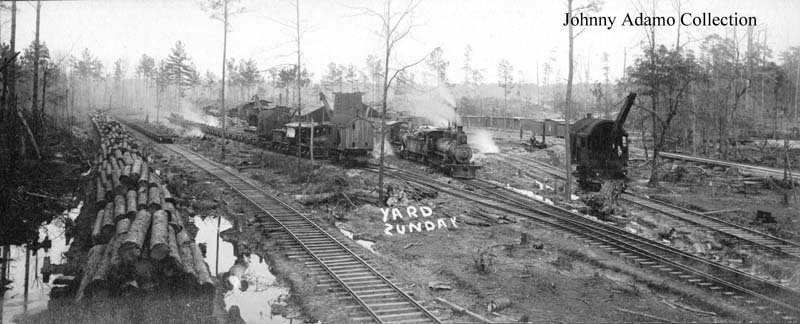
2-6-0 Number 53 at Eastman, Gardiner & Co.'s logging camp at Summerland in 1906. Four Barnhart loaders are visible in the photo. |
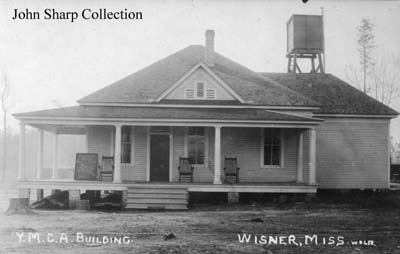
The Eastman, Gardiner & Co. camp at Wisner was one of the first in the country to feature a YMCA in 1909. |
|
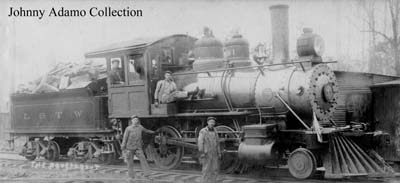
Rare 2-4-0 Number 61 was built new for Eastman, Gardiner & Co. by Baldwin and was lettered for the Laurel & Tallahoma Western, the name given to E-G's logging railroads. |
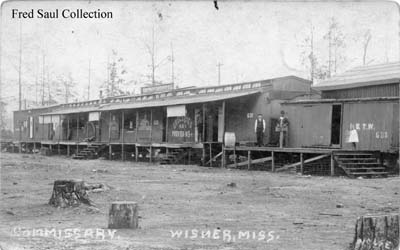
A feature of most Eastman, Gardiner & Co. logging camps was the group of boxcars converted to commissary cars, including a meat market, drug store, clothing store, and pay car. |
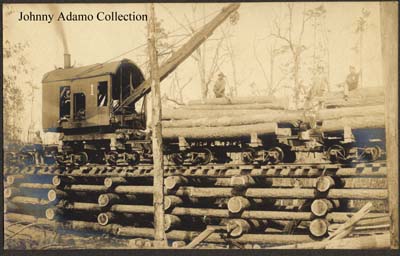
One of Eastman, Gardiner & Co.'s Barnhart log loaders loading on a crib trestle about 1906. |
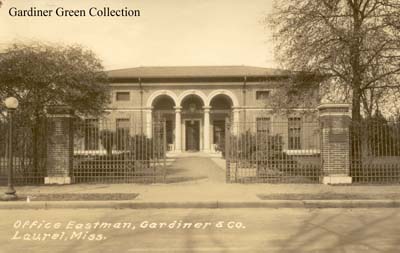
Eastman, Gardiner & Co.'s elegant office building in Laurel was completed in 1912 and still stands as a landmark in Laurel today. |
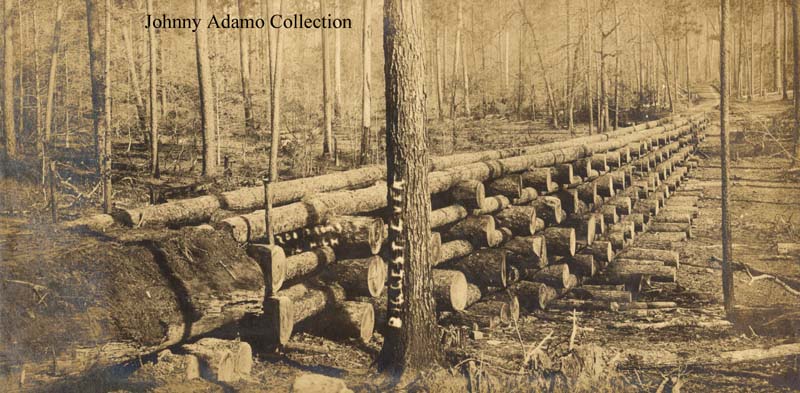
A crib trestle made of pine logs is nearly complete and ready for the section gang to lay track in this 1906 photo. |
|
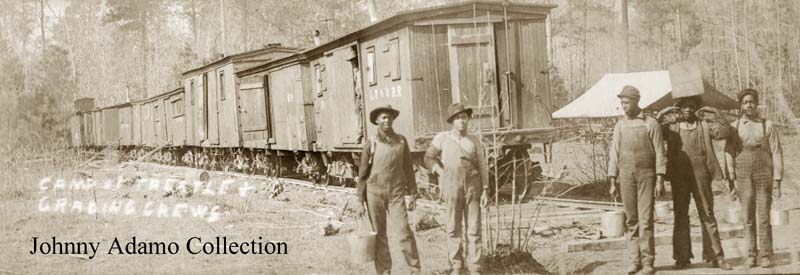
The caption states this 1906 photo shows the camp that the trestle and grading crews stayed in ahead of the logging crews. |
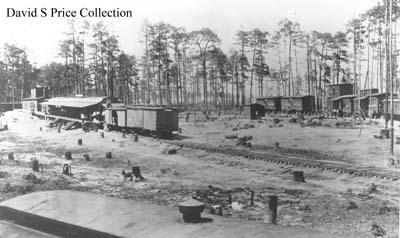
The Eastman, Gardiner & Co. camp at Rogers Camp is being set up in this photo. |
|
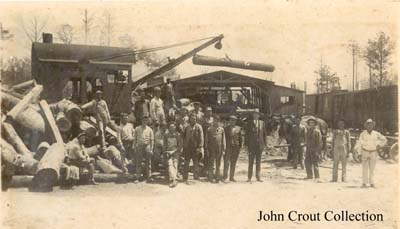
A Barnhart loader is used to move logs at the E-G sawmill at Cohay III in the late 1920's. |

The commissary cars set up at the Eastman, Gardiner & Co. camp at Summerland in 1906. |
|
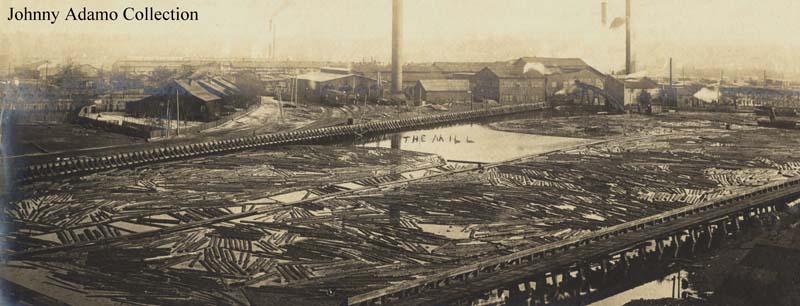
1906 view of the Eastman, Gardiner & Co. mill at Laurel shows a nearly full log pond. The photo was taken from the roof of the old Laurel Lumber Co. mill, which was bought by E-G. The company's 4 stall engine house and machine shop is also visible. |
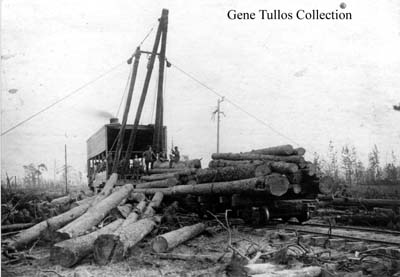
A later view of E-G's homemade combined skidder and loader. |
|
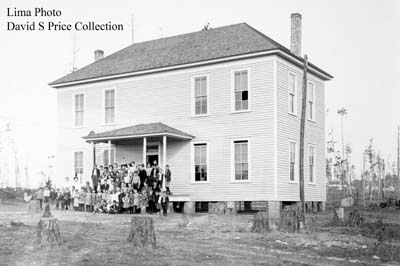
The school at the log camp at Wisner about 1910. |
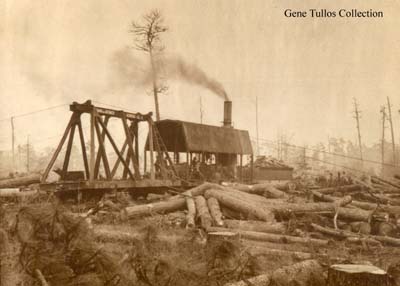
One of Eastman, Gardiner & Co.'s home-built skidders. |
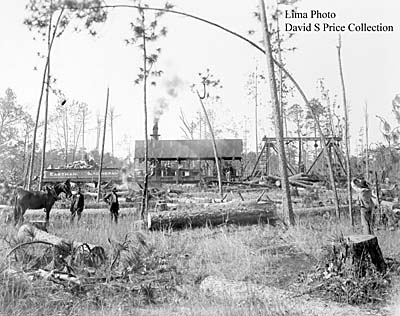
Another view of an Eastman, Gardiner & Co. skidder in operation about 1910. |
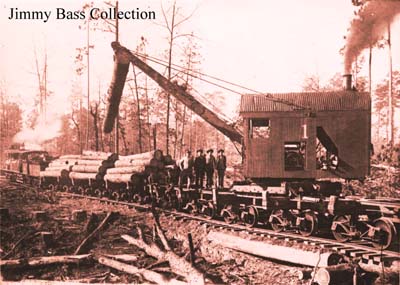
Eastman, Gardiner & Co. loading crew. |
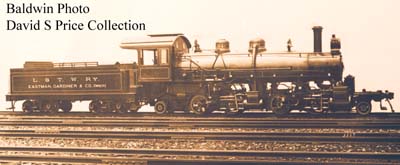
Eastman, Gardiner & Co. ordered this rare 2-4-4-2 from Baldwin, but apparently it was unsatisfactory and was sent back to the factory within a year or so. |
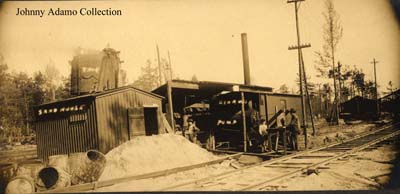
Sand house and steam-powered dynamo used to provide electricity to the camp at Summerland in 1906. Electricity was rare at this time even for a town of some size in Mississippi! |
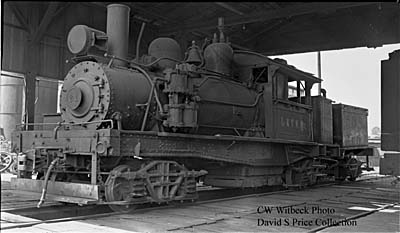
E-G Shay Number 71 was kept by successor Green Lumber Co. until about 1940. |

High water from nearby Leaf River floods the Eastman, Gardiner & Co. camp at Summerland about 1906. |
|
 September 1910 Official Guide of the Railways |
||
For more information contact Tony Howe at tonyhowe76@yahoo.com or David S. Price at davidsprice46@gmail.com
